Japan
Wood Products Prices
Dollar Exchange Rates of 25th
Oct
2024
Japan Yen 151.84
Reports From Japan
No party secures overall majority
The Liberal Democratic Party and its coalition partner
have lost their majority in the Lower House following the
27 October general election. The domestic press suggested
voters were harshly critical of candidates involved in the
Liberal Democratic Party’s financial scandal with many
protesting by voting for other candidates.
The loss of its majority would require the Prime Minister
to seek a third party to join the coalition to remain in
power. The Constitutional Democratic Party of Japan, the
largest opposition force, increased its seats. At least one of
the two smaller opposition parties that also made gains in
the election could now play the role of kingmaker for the
ruling coalition.
Immediately after the election results were available the
yen exchange rate against the US$ fell a three-month low
as investors concluded that the political landscape would
likely slow future interest rate hikes. The downward trend
of the yen was heightened by a stronger US dollar. The
yen hit its weakest since late July at 153.3 and fell
to165.36 against the euro.
The yen weakened after opposition parties gained a
significant extra number of seats following the recent
general election which the media say pushes Japan into a
period of heightened political uncertainty.
Analysts commented that the pace of interest rate
increases could be slowed as opposition parties have more
influence in policymaking.
See:
https://www.japantimes.co.jp/news/2024/10/28/japan/politics/lo
wer-house-election-results/
SMEs would suffer if minimum wage raised too quickly
In advance of the general election held on 27 October
political parties in Japan were promising to raise the
minimum wage but analysts were quick to point out such a
move would undermine the fragile recovery of small and
midsize companies. The wage-hike pledges threaten small
businesses which account for two-thirds of jobs and over
half of economic output as they are already struggling to
manage rising costs.
The political parties did not offer any suggestions on how
they would help firms offset the cost of a higher minimum
wage prompting Japan’s main business federation to urge
caution.
The head of the Federation Masakazu Tokura told a press
conference “We must aim for challenging goals as a whole
but I feel uneasy about pushing something that is utterly
impossible” adding that the pace of wage hikes needed to
hit the minimum wage hike goal may be hard for many
small companies to adopt.
See: https://www.asahi.com/ajw/articles/15479621
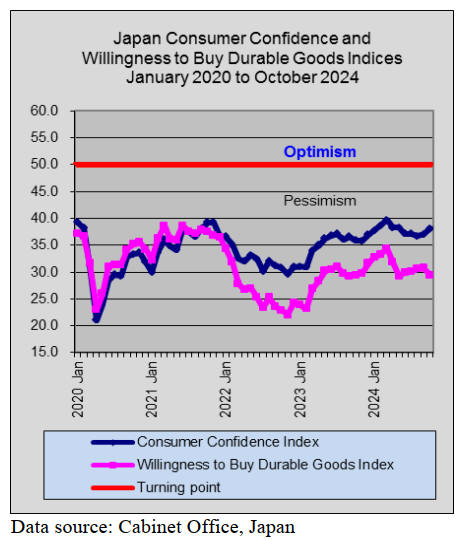
Economy drivers shifting from external back to
domestic demand
A report from Deloitte ‘Japan Economic Outlook’ of
October 2024 points to the driver of Japan’s economy
shifting back from external to domestic demand but
suggests domestic demand growth will continue but future
gains will be modest as inflation limits the benefits of
stronger wage growth.
The recent rise in wages has finally given households the
confidence they needed to spend more. A stronger yen
would also help alleviate some inflationary pressures
which will further bolster consumer spending. However,
inflation is likely to remain an issue in the near term, says
the Deloitte report, which will keep the pace of spending
relatively modest.
See: https://www2.deloitte.com/us/en/insights/economy/asia-
pacific/japan-economic-outlook.html
Fourth monthly fall in factory activity
Japan's factory activity contracted for the fourth straight
month in October on subdued demand and weak orders, a
private-sector survey showed. The index stayed below the
50.0 threshold separating growth from contraction for a
fourth straight month.

The Coincident Index released by the Cabinet Office
is a
single summary statistic that tracks the current state of the
Japanese economy. A rise in the index indicates an
expansion of economic activity and a decline in the index
indicates a contraction in economic activity.
See:
https://www.japantimes.co.jp/business/2024/10/24/economy/japa
n-factory-activity-october/
Exports weak mid year
Year on year, Japanese exports fell in the April-September
period as the economic downturn in China and stalled
automobile demand in the US canceled the advantage of
the weak yen. The country recorded a trade deficit of 3.11
trillion yen (US$20.6 billion) between April-September
term marking a seventh straight monthly deficit.
See: https://www3.nhk.or.jp/nhkworld/en/news/20241017_B04/
Record number of female CEOs
According to a survey by credit research firm Tokyo
Shoko Research, the number of female CEOs in Japan hit
a record 649,262 this year, comprising more than 15% of
all CEOs for the first time.
The annual survey also showed that the number of
female
presidents among 4.25 million companies had increased
threefold from 2010 when the figure was just above
210,000.
The Research team commented that “support by the
central and local governments for women to start
businesses as well as efforts to improve working
conditions for women are steadily improving”.
See: https://www.japantimes.co.jp/business/2024/10/25/female-
presidents-survey/
Weak yen boost to exports but households face rising
prices of imports
Nada Choueiri, the IMF Mission Chief in Japan has said
the weak yen is beneficial for Japan's economy as the
benefit to the economy from higher exports exceeds the
increase in the cost of imports. a view that ignores the
negative impact on households from rising prices of
imported fuel and food.
Choueiri urged Japan to raise interest rates at a gradual
pace and compile supplementary budgets only when a big
shock hits the economy.
See:https://www.channelnewsasia.com/business/imf-sees-weak-
yen-beneficial-japans-economy-4703136
The Bank of Japan concluded its two-day policy meeting
on the 31st October maintaining interest rates at 0.25%
and continuing to signal its intention to raise rates when
the time is right.
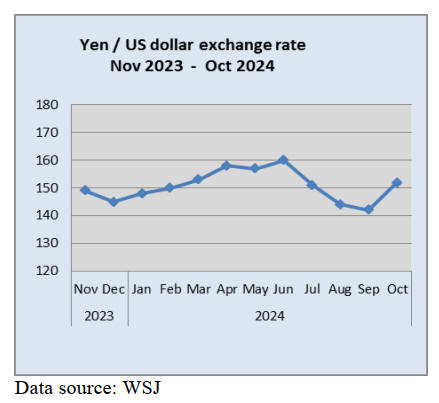
Household debt outpacing income
According to a Ministry of Internal Affairs’ ‘Family
Income and Expenditure Survey’ Japanese household debt
is outpacing income due to surging home prices and this is
raising concern about the ability of borrowers to keep up
with payments as interest rates are likely to rise.
Liabilities held by households of two or more averaged
6.55 million yen (US$43,500) in 2023 exceeding the
average annual income of 6.42 million yen for the first
time since records began in 2002.
See: https://asia.nikkei.com/Business/Markets/Property/Japan-s-
growing-mortgages-lift-household-debt-above-income
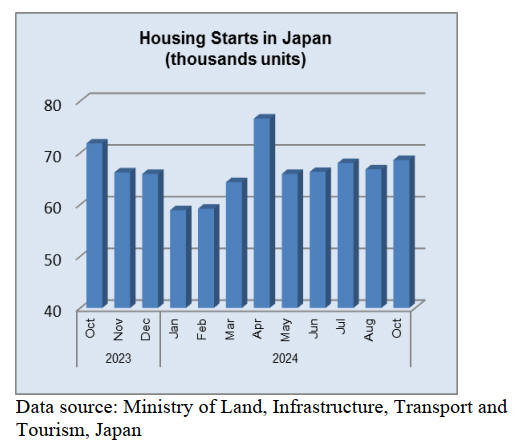
Launch of COP29 Japan Pavilion websites
In advance of the 29th Conference of the Parties to the
United Nations Framework Convention on Climate
Change (COP29), the Ministry of the Environment (MOE)
launched webpages on the showcases and seminars to be
held at the Japan Pavilion.
The MOE will exhibit Japan's environmental technologies
and climate initiatives at the Japan Pavilion during COP29
in Baku, Republic of Azerbaijan. The virtual showcase site
has also been designed to show additional technologies
over and above those shown in the on-site pavilion.
See: https://www.env.go.jp/earth/cop/cop29/pavilion/en/
and
https://jprsi.go.jp/en/cop29/showcase
Import update
Assembled wooden flooring imports
After two consecutive monthly increases the value of
assembled wooden flooring (HS441871-79) reversed
direction in August, dropping 15% compared to the
previous month. This brought the value of August imports
down to the level seen in May.
As in previous months the main category of assembled
flooring imports was HS441875, accounting for 72% of
the total value of assembled flooring imports, slightly up
from the previous month. The second largest category in
terms of value was HS441879 (8%) followed by
HS441874 (4%). Of HS441875 imports 45% was provded
by shippers in China, 25% by shippers in Vietnam and
17% from shippers in Italy.
Two other countries shipping assembled flooring
(HS441875) to Japan in August were Thailand and
Malaysia. The value of August arrivals of assembled
wooden flooring was little changed from the value in
August 2023.

Plywood imports
The volume of August plywood imports (441210-39) was
129,826 cu.m, this was around the same level imported in
July. Year on year the volume of August plywood was
down 8% but compared to a month earlier August import
volumes were up 20%
In August plywood arrivals from China and Vietnam were
down compared to levels in July while arrivals from
Malaysia rose month on month. August arrivals from
Indonesia were at around the same level as in July.
As in previous months, of the various categories of
plywood imported August most was HS441231. Of total
shipments from Malaysia and Indonesia, over 90% was
HS441231. Shipments from China were more varied with
HS441233 and HS441239 accounting for around 40%
each of August shipments with HS441231 accounting for
most of the balance.
Shippers in Vietnam supplied mainly HS441231 (69%)
with HS441234 making up most of the balance. Other
shippers appearing in Japan’s plywood import statistics in
August included Finland and Latvia.
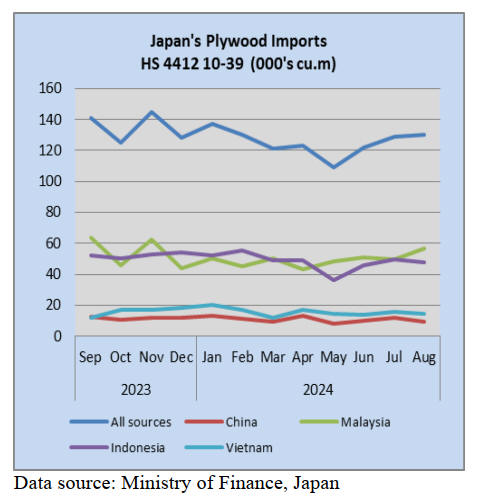
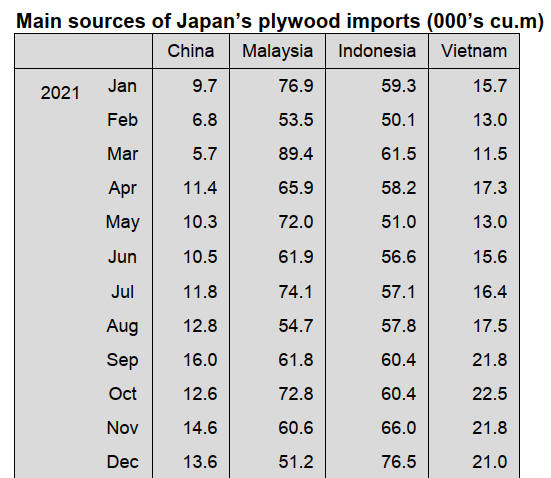 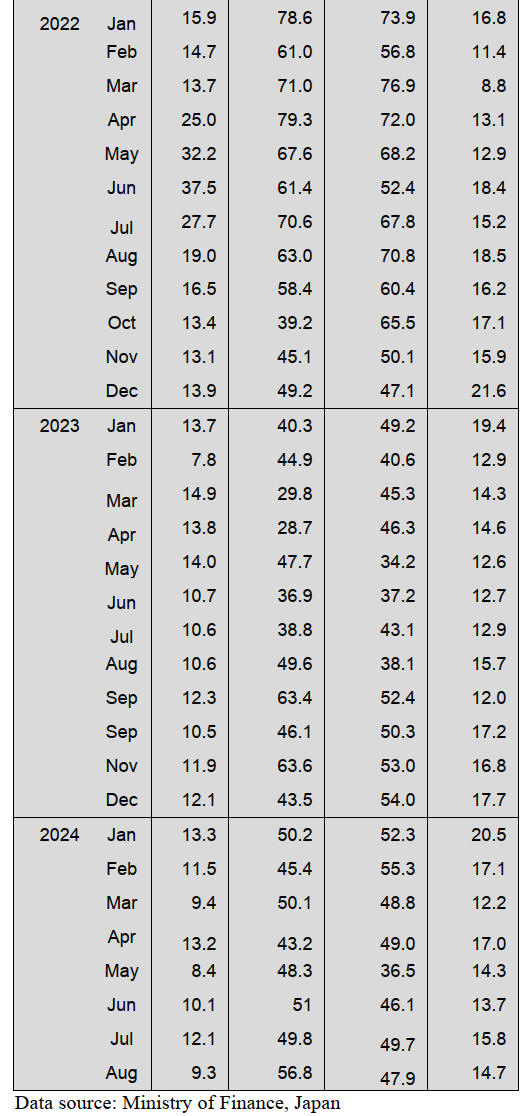
Trade news from the Japan Lumber Reports (JLR)
The Japan Lumber Reports (JLR), a subscription trade
journal published every two weeks in English, is
generously allowing the ITTO Tropical Timber Market
Report to reproduce news on the Japanese market
precisely as it appears in the JLR.
For the JLR report please see:
https://jfpj.jp/japan_lumber_reports/
Orders for house builders
Orders for major housing companies and house builders in
August, 2024 exceed the result of August, 2023. A number
of buildings is low but the price for per building is high.
However, it is hard to say that the house market is lively.
Demand for a high-priced building is stable. Wealthy
people think that buying a house is not going to be
influenced by the real wages, which is difficult to grow.
The competition to get customers among housing
companies is getting fierce.
The companies struggle with selling a level of thirty
million yen house. However, there are inquires for lumber
of one-story house and they help the sales. Orders for
rental houses are firm.
Many housing companies have good results in unit built
for sale. Orders for remodeling are very good. Many
housing companies strengthen in building eco-friendly
houses because demand for eco-friendly products will
keep increasing in the future.
South Sea logs and products
6,833 cbms of South Sea logs have been delivered to
Japan from Sabah and Sarawak in August. Also South Sea
Logs from Papua New Guinea in July 2024 so there is a
shortage so far.
Lumber manufacturers in Japan have orders for blocks
from steel or shipbuilding companies stably and demand
and supply are balanced in Japan.
There are constant inquiries to South Sea or Chinese
lumber. Lumber for decks are popular for condominiums
or second houses. There are enough lumber for truck
bodies so inquiries settled down.
The price of laminated boards is raised slightly in South
Asia due to the strong yen. Japanese buyers accept the
price hike
Demand and supply for lumber in 2023
Demand for lumber in 2023 was 79,853,000 cbms, 6.1 %
less than 2022. This is for the first time in three years to be
below 80,000,000 cbms.
Demand for wooden fuels increases but demand for
lumber, plywood, pulp, and chips decrease by two-digit
numbers. Domestic and imported lumber do not exceed
the 2022’s result but volume of imported lumber dropped
widely so the self-sufficiency rate of wood rises to 42.9 %,
2.2 points up from the previous year. This is for the first
time in fifty-one years to become the standard.
The domestic lumber is 34,259,000 cbms, 1 % less and the
imported lumber is 45,594,000 cbms, 9.7 % less than the
previous year.
The new starts and the floor areas decrease so the
consumption of lumber is influenced by these facts.
Especially, the imported structural lumber is 13,088,000
cbms, 28.2 % down from the previous year.
There are several reasons for the decrease and they are low
demand for lumber and high procurement cost due to the
weak yen. Japanese purchasing power has been weakening
and Japanese buyers could not negotiate about the price of
lumber with suppliers in overseas.
Demand for lumber is 21,790,000 cbms, 17.0 % down.
Demand for plywood is 7,474,000 cbms, 23.9 % down and
for pulp / chip is 27,797,000 cbms, 5.9 % down from
2022.
On the other hand, pulp / chip made in Japan increases
nearly 5 % from the previous year. Paper and paperboard
are needed for packing products on online-shopping. Also,
it is needed for sanitary goods for the elderly or inbound
tourists.
However, demand and supply for pulp / chip is balanced
contraction and several plants reorganize or close
operations. Demand and supply for wooden pellet increase
in domestic and imported wooden pellet. Many wood
biomass power plants had started operations after FIT
(Feed - in Tariffs) was enforced.
Especially, demand for wooden pellet at coal fired power
plants has increased. Imported wooden pellet is 9,156,000
cbms, 28.5 % up. 1 ton is converted into 1.282 cbms.
Exports of lumber is 3,395,000 cbms, 11.6 % up and of
logs is 1,595,000 cbms, 20.5 % up from last year. Exports
of pulp/chips is 1,371,000 cbms, 14.5 % increased.
The self-sufficiency rate of lumber is 38.6 %, 2.8 points
more than 2022. The total self-sufficiency rate of wood is
42.9 %, 2.2 points up from the previous year. It is about 24
points up from 2020, when year-on-year comparison was
18.8 %.
|